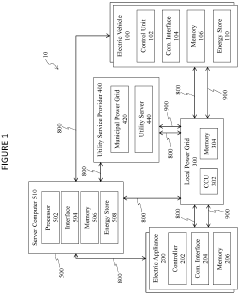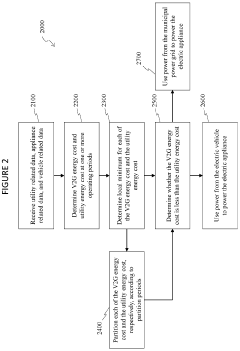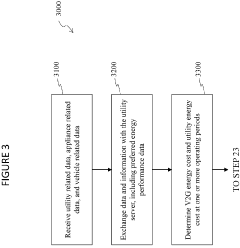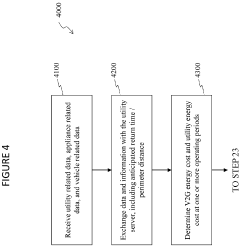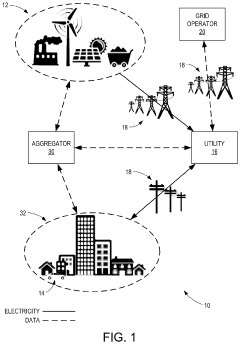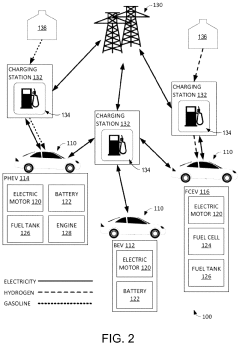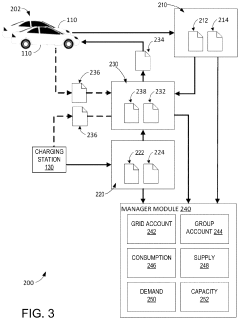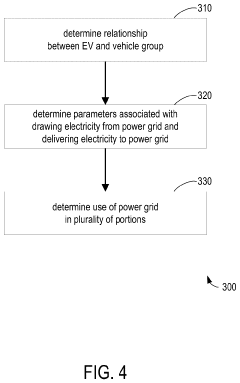Legal Frameworks Governing Vehicle-to-Grid Technology
SEP 23, 20259 MIN READ
Generate Your Research Report Instantly with AI Agent
Patsnap Eureka helps you evaluate technical feasibility & market potential.
V2G Technology Background and Objectives
Vehicle-to-Grid (V2G) technology represents a transformative approach to energy management that has evolved significantly over the past decade. This bidirectional power flow system enables electric vehicles (EVs) to not only consume electricity from the grid but also return excess energy back to it when needed. The concept originated in the late 1990s but gained substantial momentum after 2010 as electric vehicle adoption increased and smart grid technologies matured.
The evolution of V2G technology has been driven by three primary factors: advancements in battery technology, development of sophisticated power electronics, and the growing need for grid flexibility. Early V2G systems were limited by battery degradation concerns and rudimentary communication protocols. However, recent innovations in battery chemistry and battery management systems have significantly reduced these limitations, extending battery life even under bidirectional charging conditions.
From a technical perspective, V2G systems comprise several key components: bidirectional chargers, communication interfaces, energy management systems, and grid integration protocols. The technology has progressed from basic unidirectional smart charging (V1G) to full bidirectional capabilities (V2G), with intermediate developments including vehicle-to-home (V2H) and vehicle-to-building (V2B) applications.
The primary technical objectives of V2G technology development include optimizing bidirectional power flow efficiency, minimizing battery degradation, establishing standardized communication protocols, and ensuring seamless grid integration. Additionally, there are significant goals related to developing robust legal frameworks that can accommodate this novel technology while protecting both consumers and grid stability.
Current technical targets focus on achieving charging/discharging efficiency above 90%, reducing response times to grid signals to under 5 seconds, and developing universal standards for V2G communication. The IEEE 2030.5 and ISO 15118 standards represent important steps toward interoperability, though complete standardization remains an ongoing challenge.
The legal and regulatory landscape surrounding V2G technology is still evolving, with significant variations across different jurisdictions. Key regulatory considerations include grid interconnection requirements, electricity market participation rules, consumer protection frameworks, and compensation mechanisms for grid services provided by EVs. The development of comprehensive legal frameworks is crucial for the widespread adoption of V2G technology and represents one of the most significant challenges in this field.
The evolution of V2G technology has been driven by three primary factors: advancements in battery technology, development of sophisticated power electronics, and the growing need for grid flexibility. Early V2G systems were limited by battery degradation concerns and rudimentary communication protocols. However, recent innovations in battery chemistry and battery management systems have significantly reduced these limitations, extending battery life even under bidirectional charging conditions.
From a technical perspective, V2G systems comprise several key components: bidirectional chargers, communication interfaces, energy management systems, and grid integration protocols. The technology has progressed from basic unidirectional smart charging (V1G) to full bidirectional capabilities (V2G), with intermediate developments including vehicle-to-home (V2H) and vehicle-to-building (V2B) applications.
The primary technical objectives of V2G technology development include optimizing bidirectional power flow efficiency, minimizing battery degradation, establishing standardized communication protocols, and ensuring seamless grid integration. Additionally, there are significant goals related to developing robust legal frameworks that can accommodate this novel technology while protecting both consumers and grid stability.
Current technical targets focus on achieving charging/discharging efficiency above 90%, reducing response times to grid signals to under 5 seconds, and developing universal standards for V2G communication. The IEEE 2030.5 and ISO 15118 standards represent important steps toward interoperability, though complete standardization remains an ongoing challenge.
The legal and regulatory landscape surrounding V2G technology is still evolving, with significant variations across different jurisdictions. Key regulatory considerations include grid interconnection requirements, electricity market participation rules, consumer protection frameworks, and compensation mechanisms for grid services provided by EVs. The development of comprehensive legal frameworks is crucial for the widespread adoption of V2G technology and represents one of the most significant challenges in this field.
Market Demand Analysis for V2G Solutions
The Vehicle-to-Grid (V2G) technology market is experiencing significant growth driven by the convergence of renewable energy integration, grid stability concerns, and electric vehicle proliferation. Current market analysis indicates that the global V2G market is projected to reach $17.43 billion by 2027, growing at a compound annual growth rate of approximately 48% from 2020 to 2027. This exceptional growth trajectory reflects the increasing recognition of EVs as mobile energy storage units rather than mere transportation assets.
Primary market demand for V2G solutions stems from utility companies seeking grid stabilization mechanisms. As renewable energy sources like wind and solar contribute increasingly larger portions of the energy mix, their intermittent nature creates challenges for grid operators. V2G technology offers a compelling solution by enabling bidirectional power flow, allowing EVs to discharge stored energy back to the grid during peak demand periods, thereby reducing the need for expensive peaker plants and enhancing grid resilience.
Fleet operators represent another significant market segment, with commercial fleets increasingly transitioning to electric vehicles. These operators view V2G as a revenue-generating opportunity, potentially offsetting the higher initial investment costs of electric vehicles through participation in grid services markets. Market research indicates that fleet operators can generate additional revenue of $100-$200 per vehicle monthly through V2G participation, creating a compelling business case for fleet electrification.
Residential consumers constitute an emerging market segment, particularly in regions with time-of-use electricity pricing or high renewable energy penetration. Consumer interest in energy independence and reducing electricity costs drives adoption, with early adopters demonstrating willingness to participate in V2G programs that offer financial incentives or contribute to grid sustainability.
Geographically, Europe leads V2G market development, supported by progressive regulatory frameworks and ambitious decarbonization targets. The United Kingdom, Denmark, and the Netherlands have implemented particularly favorable policies and pilot programs. North America follows, with California spearheading V2G initiatives through its aggressive renewable energy mandates and supportive regulatory environment.
Market barriers include technological standardization challenges, battery degradation concerns, and complex regulatory landscapes. The absence of unified technical standards across vehicle manufacturers and charging infrastructure creates interoperability issues that hinder widespread adoption. Additionally, consumer awareness remains limited, with many potential users unfamiliar with V2G concepts and benefits.
Despite these challenges, market indicators suggest accelerating demand as regulatory frameworks mature and technology costs decline. The convergence of decarbonization policies, grid modernization initiatives, and electric vehicle adoption creates a favorable environment for V2G technology proliferation over the next decade.
Primary market demand for V2G solutions stems from utility companies seeking grid stabilization mechanisms. As renewable energy sources like wind and solar contribute increasingly larger portions of the energy mix, their intermittent nature creates challenges for grid operators. V2G technology offers a compelling solution by enabling bidirectional power flow, allowing EVs to discharge stored energy back to the grid during peak demand periods, thereby reducing the need for expensive peaker plants and enhancing grid resilience.
Fleet operators represent another significant market segment, with commercial fleets increasingly transitioning to electric vehicles. These operators view V2G as a revenue-generating opportunity, potentially offsetting the higher initial investment costs of electric vehicles through participation in grid services markets. Market research indicates that fleet operators can generate additional revenue of $100-$200 per vehicle monthly through V2G participation, creating a compelling business case for fleet electrification.
Residential consumers constitute an emerging market segment, particularly in regions with time-of-use electricity pricing or high renewable energy penetration. Consumer interest in energy independence and reducing electricity costs drives adoption, with early adopters demonstrating willingness to participate in V2G programs that offer financial incentives or contribute to grid sustainability.
Geographically, Europe leads V2G market development, supported by progressive regulatory frameworks and ambitious decarbonization targets. The United Kingdom, Denmark, and the Netherlands have implemented particularly favorable policies and pilot programs. North America follows, with California spearheading V2G initiatives through its aggressive renewable energy mandates and supportive regulatory environment.
Market barriers include technological standardization challenges, battery degradation concerns, and complex regulatory landscapes. The absence of unified technical standards across vehicle manufacturers and charging infrastructure creates interoperability issues that hinder widespread adoption. Additionally, consumer awareness remains limited, with many potential users unfamiliar with V2G concepts and benefits.
Despite these challenges, market indicators suggest accelerating demand as regulatory frameworks mature and technology costs decline. The convergence of decarbonization policies, grid modernization initiatives, and electric vehicle adoption creates a favorable environment for V2G technology proliferation over the next decade.
V2G Technical Challenges and Regulatory Landscape
Vehicle-to-Grid (V2G) technology faces significant technical challenges that must be addressed for widespread implementation. The bidirectional power flow between electric vehicles and the grid requires sophisticated power electronics capable of managing variable loads while maintaining power quality. Current inverter technologies struggle with efficiency losses during conversion processes, typically ranging from 10-15% in commercial systems. Additionally, battery degradation concerns remain paramount, as frequent charging and discharging cycles associated with V2G operations can reduce battery lifespan by up to 30% without proper management systems.
Communication protocols present another substantial hurdle. While standards like ISO 15118, OpenADR, and OCPP exist, interoperability between different vehicle manufacturers, charging infrastructure providers, and grid operators remains fragmented. This fragmentation creates significant barriers to scaling V2G technology across diverse markets and utility systems.
The regulatory landscape surrounding V2G technology varies considerably across jurisdictions, creating a complex environment for implementation. In the United States, FERC Order 2222 represents a milestone by allowing distributed energy resources, including V2G-enabled vehicles, to participate in wholesale electricity markets. However, implementation details are left to regional transmission organizations, resulting in inconsistent market access rules.
The European Union has established more comprehensive frameworks through directives like the Clean Energy Package and the Alternative Fuels Infrastructure Regulation, which explicitly recognize electric vehicles as potential grid assets. These regulations mandate standardized payment systems and transparent pricing for V2G services, though member states' implementation timelines vary significantly.
In Asia, Japan's approach centers on resilience, with regulations facilitating V2G as part of disaster preparedness infrastructure. China, meanwhile, has integrated V2G into its broader electric vehicle industrial policy, with regulations focusing on technical standardization rather than market participation rules.
Regulatory gaps persist in critical areas including dynamic electricity pricing mechanisms, battery ownership models, and liability frameworks for grid services. Most jurisdictions lack clear rules regarding compensation for battery degradation resulting from grid services, creating uncertainty for both vehicle owners and fleet operators. Additionally, data privacy regulations surrounding the collection and use of vehicle charging data remain underdeveloped in most markets.
Tax structures and incentive programs also vary widely, with some jurisdictions offering reduced electricity rates or tax benefits for V2G participation, while others maintain regulatory barriers that effectively prevent consumer participation in energy markets.
Communication protocols present another substantial hurdle. While standards like ISO 15118, OpenADR, and OCPP exist, interoperability between different vehicle manufacturers, charging infrastructure providers, and grid operators remains fragmented. This fragmentation creates significant barriers to scaling V2G technology across diverse markets and utility systems.
The regulatory landscape surrounding V2G technology varies considerably across jurisdictions, creating a complex environment for implementation. In the United States, FERC Order 2222 represents a milestone by allowing distributed energy resources, including V2G-enabled vehicles, to participate in wholesale electricity markets. However, implementation details are left to regional transmission organizations, resulting in inconsistent market access rules.
The European Union has established more comprehensive frameworks through directives like the Clean Energy Package and the Alternative Fuels Infrastructure Regulation, which explicitly recognize electric vehicles as potential grid assets. These regulations mandate standardized payment systems and transparent pricing for V2G services, though member states' implementation timelines vary significantly.
In Asia, Japan's approach centers on resilience, with regulations facilitating V2G as part of disaster preparedness infrastructure. China, meanwhile, has integrated V2G into its broader electric vehicle industrial policy, with regulations focusing on technical standardization rather than market participation rules.
Regulatory gaps persist in critical areas including dynamic electricity pricing mechanisms, battery ownership models, and liability frameworks for grid services. Most jurisdictions lack clear rules regarding compensation for battery degradation resulting from grid services, creating uncertainty for both vehicle owners and fleet operators. Additionally, data privacy regulations surrounding the collection and use of vehicle charging data remain underdeveloped in most markets.
Tax structures and incentive programs also vary widely, with some jurisdictions offering reduced electricity rates or tax benefits for V2G participation, while others maintain regulatory barriers that effectively prevent consumer participation in energy markets.
Current V2G Implementation Frameworks
01 Bidirectional charging systems for V2G integration
Bidirectional charging systems enable electric vehicles to not only draw power from the grid but also feed power back when needed. These systems include specialized hardware and control algorithms that manage the flow of electricity between vehicles and the grid. The technology allows for optimal energy transfer while protecting both vehicle batteries and grid infrastructure, creating a symbiotic relationship between EVs and power networks.- Bidirectional charging systems for V2G integration: Bidirectional charging systems enable electric vehicles to not only draw power from the grid but also feed power back when needed. These systems include specialized hardware and control mechanisms that manage the flow of electricity between the vehicle battery and the power grid. The technology allows for optimal energy management, grid stabilization during peak demand periods, and potential revenue generation for EV owners through energy trading.
- Smart grid communication and management protocols: Advanced communication protocols and management systems are essential for effective Vehicle-to-Grid implementation. These technologies enable real-time data exchange between vehicles, charging stations, and grid operators. Smart systems can analyze grid conditions, predict energy demands, coordinate charging/discharging schedules, and implement dynamic pricing models to incentivize beneficial grid behaviors from EV owners.
- Energy storage and distribution optimization: V2G technology incorporates sophisticated energy storage and distribution optimization algorithms. These systems determine the most efficient ways to utilize vehicle batteries as distributed energy resources. The technology considers factors such as battery state of charge, grid demand forecasts, renewable energy availability, and electricity pricing to maximize economic benefits while minimizing battery degradation and ensuring vehicle readiness for transportation needs.
- V2G infrastructure and charging station design: Specialized infrastructure and charging station designs are required to support V2G functionality. These include hardware components like bidirectional inverters, grid connection equipment, and safety systems. Modern V2G charging stations incorporate advanced metering, authentication systems, and user interfaces that allow vehicle owners to set preferences for energy sharing. The infrastructure must comply with grid interconnection standards while ensuring electrical safety and system reliability.
- Grid stabilization and renewable energy integration: V2G technology serves as a critical tool for grid stabilization and renewable energy integration. Electric vehicles can function as mobile energy storage units that help balance supply and demand fluctuations, particularly from intermittent renewable sources like solar and wind. By absorbing excess renewable generation and providing power during shortfalls, V2G systems help maintain grid frequency, reduce the need for peaker plants, and enable higher penetration of clean energy sources.
02 Grid stabilization and demand response management
Vehicle-to-Grid technology provides significant benefits for grid stabilization by allowing electric vehicles to serve as distributed energy resources. During peak demand periods, EVs can supply power back to the grid, helping to balance load and reduce strain on power generation facilities. Advanced algorithms coordinate multiple vehicles to respond to grid signals, enabling frequency regulation, voltage support, and other ancillary services that enhance overall grid reliability and resilience.Expand Specific Solutions03 Smart charging infrastructure and communication protocols
Effective V2G implementation requires sophisticated charging infrastructure with bidirectional capabilities and robust communication systems. These smart charging stations incorporate protocols that enable real-time data exchange between vehicles, charging points, and grid operators. The infrastructure includes security features to protect against cyber threats while facilitating seamless integration with existing power systems and enabling automated participation in energy markets.Expand Specific Solutions04 Battery management and vehicle integration systems
Specialized battery management systems are crucial for V2G technology to ensure that power discharge to the grid doesn't compromise vehicle battery health or longevity. These systems monitor battery state of charge, temperature, and degradation factors while optimizing charging and discharging cycles. Vehicle integration components coordinate between the vehicle's power electronics and the grid interface, ensuring safe operation while maximizing the value of grid services provided.Expand Specific Solutions05 Economic models and incentive structures for V2G adoption
The economic framework supporting V2G technology includes innovative business models and incentive structures that compensate vehicle owners for providing grid services. These models calculate the value of energy arbitrage, frequency regulation, and other services while accounting for battery degradation costs. Payment systems and market participation mechanisms enable EV owners to monetize their vehicle's battery capacity during idle periods, creating additional revenue streams that can offset vehicle ownership costs.Expand Specific Solutions
Key Industry Players in V2G Ecosystem
The legal framework for Vehicle-to-Grid (V2G) technology is evolving within a competitive landscape characterized by early market development and growing potential. Currently, the market is in its nascent stage with regulatory frameworks still forming across jurisdictions. Major automotive players like Volkswagen, Audi, Toyota, Hyundai, and Ford are investing in V2G capabilities, while technology companies such as Qualcomm, Intel, and Bosch are developing enabling components. Energy storage specialists like Contemporary Amperex Technology are advancing battery technologies critical for V2G implementation. Telecommunications companies including Ericsson and AT&T are contributing to connectivity solutions. The technology's maturity varies significantly across regions, with regulatory harmonization remaining a key challenge for widespread adoption and standardization.
Volkswagen AG
Technical Solution: Volkswagen AG has developed a comprehensive Vehicle-to-Grid (V2G) legal framework solution called "Elli" (Electric Life) that addresses regulatory challenges across multiple jurisdictions. Their approach includes standardized grid connection protocols that comply with ISO 15118 and IEC 61851 standards for secure vehicle-to-grid communication[3]. Volkswagen has also pioneered a "regulatory sandbox" approach, working with authorities in Germany and other EU countries to test V2G implementations in controlled environments before wider deployment. Their legal framework addresses four key areas: grid integration regulations, payment and settlement mechanisms, data privacy compliance (particularly with GDPR in Europe), and liability frameworks that clearly delineate responsibilities between vehicle owners, charging infrastructure operators, and utilities[7]. Volkswagen has also developed contract templates for V2G participation that comply with energy market regulations across different regions.
Strengths: Strong European regulatory expertise with established relationships with EU regulatory bodies; comprehensive approach covering technical, financial and privacy aspects. Weaknesses: Framework heavily focused on European markets with less development in North American and Asian regulatory environments; implementation still limited by varying national regulations within the EU.
Ford Global Technologies LLC
Technical Solution: Ford has developed a multi-tiered legal framework for V2G technology called "BlueOval Charge Network" that addresses the complex regulatory landscape across different markets. Their approach focuses on creating standardized agreements between vehicle owners, utilities, and grid operators that comply with Federal Energy Regulatory Commission (FERC) requirements in the US and similar bodies internationally[2]. Ford's framework includes specific provisions for regulatory compliance with energy market participation rules, allowing electric vehicles to participate in ancillary service markets while addressing the legal challenges of aggregating distributed energy resources. Their system incorporates smart contracts that automatically manage regulatory compliance across jurisdictions, with built-in mechanisms to adapt to changing regulations[5]. Ford has also pioneered "opt-in" consent mechanisms that address data privacy concerns while enabling grid participation, with clear delineation of data ownership rights between vehicle owners, Ford, and utility companies. Their framework includes standardized liability provisions that protect consumers while enabling grid services.
Strengths: Strong focus on North American regulatory environments with practical implementation experience; innovative approach to consumer consent and data rights. Weaknesses: Less developed framework for European and Asian markets; relies heavily on third-party aggregators in some markets which adds complexity to the legal structure.
Critical Patents and Standards in V2G Technology
Systems and methods for integrating on-premises electric appliances with vehicle-to-grid electric vehicles
PatentActiveUS11407325B2
Innovation
- An energy management system that includes a local power grid, an electric vehicle capable of bi-directional energy exchange, and a system server that receives and analyzes utility, appliance, and vehicle data to determine optimal energy usage states, controlling the electric vehicle to discharge energy to the grid when it is cheaper or greener, thereby optimizing energy costs and reducing peak loads.
Methods and systems for managing vehicle-grid integration
PatentActiveUS12038726B2
Innovation
- A vehicle-grid integration (VGI) management system that includes computer storage media and processors to determine the use of the power grid by EVs in a dual multi-part rate structure, allowing for organized and controllable participation of EVs in power and energy management, enabling strategic dispatching to balance supply and demand, and equitably attribute costs and benefits.
Cross-Jurisdictional Compliance Requirements
Vehicle-to-Grid (V2G) technology operates within a complex web of regulatory frameworks that vary significantly across different jurisdictions. Companies implementing V2G solutions must navigate multiple compliance requirements that span energy regulations, grid interconnection standards, and consumer protection laws across different countries and regions.
In the European Union, V2G operations are governed by the Clean Energy Package, which includes specific provisions for energy storage and grid services. The EU's Network Codes establish technical requirements for grid connection, while the General Data Protection Regulation (GDPR) imposes strict rules on the handling of consumer energy usage data. Additionally, each member state maintains its own national grid codes and energy market regulations that must be adhered to.
The United States presents a particularly fragmented regulatory landscape, with requirements varying at federal, state, and local levels. The Federal Energy Regulatory Commission (FERC) Order 841 opened wholesale markets to energy storage resources, but implementation differs across regional transmission organizations. States like California have pioneered V2G-friendly regulations through initiatives such as Rule 21, which standardizes grid interconnection procedures, while other states lag significantly in regulatory development.
In Asia, Japan's regulatory framework focuses on resilience and emergency power supply capabilities, with specific technical standards for bidirectional charging under the jurisdiction of METI (Ministry of Economy, Trade and Industry). China has integrated V2G into its broader electric vehicle and smart grid policies, with the National Energy Administration establishing technical standards for grid interaction that differ substantially from Western approaches.
Cross-border V2G operations face particular challenges related to technical standardization. The International Electrotechnical Commission (IEC) standards (particularly IEC 15118 for vehicle-grid communication) provide some harmonization, but implementation varies globally. Companies must adapt their V2G solutions to accommodate different communication protocols, metering requirements, and settlement procedures across markets.
Financial compliance adds another layer of complexity, with varying tax treatments for energy trading, different incentive structures, and diverse accounting requirements for grid services. Some jurisdictions classify V2G services as taxable electricity supply, while others consider them grid support services with different fiscal implications.
Successful V2G deployment requires a comprehensive compliance strategy that addresses this regulatory diversity. Companies must develop modular technical solutions that can be adapted to different regulatory environments while maintaining core functionality. Regulatory monitoring systems are essential to track evolving requirements across multiple jurisdictions, particularly as many regions are actively developing new frameworks specific to V2G technology.
In the European Union, V2G operations are governed by the Clean Energy Package, which includes specific provisions for energy storage and grid services. The EU's Network Codes establish technical requirements for grid connection, while the General Data Protection Regulation (GDPR) imposes strict rules on the handling of consumer energy usage data. Additionally, each member state maintains its own national grid codes and energy market regulations that must be adhered to.
The United States presents a particularly fragmented regulatory landscape, with requirements varying at federal, state, and local levels. The Federal Energy Regulatory Commission (FERC) Order 841 opened wholesale markets to energy storage resources, but implementation differs across regional transmission organizations. States like California have pioneered V2G-friendly regulations through initiatives such as Rule 21, which standardizes grid interconnection procedures, while other states lag significantly in regulatory development.
In Asia, Japan's regulatory framework focuses on resilience and emergency power supply capabilities, with specific technical standards for bidirectional charging under the jurisdiction of METI (Ministry of Economy, Trade and Industry). China has integrated V2G into its broader electric vehicle and smart grid policies, with the National Energy Administration establishing technical standards for grid interaction that differ substantially from Western approaches.
Cross-border V2G operations face particular challenges related to technical standardization. The International Electrotechnical Commission (IEC) standards (particularly IEC 15118 for vehicle-grid communication) provide some harmonization, but implementation varies globally. Companies must adapt their V2G solutions to accommodate different communication protocols, metering requirements, and settlement procedures across markets.
Financial compliance adds another layer of complexity, with varying tax treatments for energy trading, different incentive structures, and diverse accounting requirements for grid services. Some jurisdictions classify V2G services as taxable electricity supply, while others consider them grid support services with different fiscal implications.
Successful V2G deployment requires a comprehensive compliance strategy that addresses this regulatory diversity. Companies must develop modular technical solutions that can be adapted to different regulatory environments while maintaining core functionality. Regulatory monitoring systems are essential to track evolving requirements across multiple jurisdictions, particularly as many regions are actively developing new frameworks specific to V2G technology.
Energy Market Integration Strategies
The integration of Vehicle-to-Grid (V2G) technology into existing energy markets requires comprehensive strategies that address both technical and regulatory challenges. Energy market operators must develop frameworks that enable bidirectional power flows while maintaining grid stability and ensuring fair compensation for V2G service providers. These integration strategies must align with existing market structures while accommodating the unique characteristics of distributed vehicle batteries as energy resources.
Market coupling mechanisms represent a critical component of successful V2G integration. These mechanisms allow V2G resources to participate across multiple market segments, including wholesale energy markets, ancillary services, and capacity markets. By enabling vehicles to provide services across these segments, market coupling maximizes the value proposition for V2G participants while enhancing overall grid flexibility and resilience.
Price signal optimization stands as another essential strategy for V2G market integration. Dynamic pricing structures that accurately reflect real-time grid conditions can effectively incentivize V2G participation when grid support is most valuable. These price signals must be transparent, predictable, and sufficiently rewarding to overcome the opportunity costs associated with battery degradation and inconvenience to vehicle owners.
Aggregation models have emerged as a practical solution to address the scale limitations of individual V2G resources. By pooling multiple vehicles into virtual power plants, aggregators can meet minimum bid requirements for wholesale market participation and provide more reliable grid services. Market rules must evolve to accommodate these aggregation models, including clear frameworks for responsibility allocation and performance verification.
Settlement systems for V2G services require significant adaptation from traditional energy market mechanisms. These systems must account for the mobility of vehicles, varying connection durations, and the dual-purpose nature of EV batteries. Advanced metering infrastructure, combined with blockchain or distributed ledger technologies, can enable accurate tracking and compensation for the bidirectional energy flows characteristic of V2G operations.
Cross-sector integration between transportation and energy markets represents perhaps the most transformative aspect of V2G deployment. This integration necessitates coordination between traditionally separate regulatory domains and market structures. Successful strategies will leverage synergies between these sectors, such as using transportation data to predict V2G resource availability or incorporating charging infrastructure planning into grid expansion strategies.
Market coupling mechanisms represent a critical component of successful V2G integration. These mechanisms allow V2G resources to participate across multiple market segments, including wholesale energy markets, ancillary services, and capacity markets. By enabling vehicles to provide services across these segments, market coupling maximizes the value proposition for V2G participants while enhancing overall grid flexibility and resilience.
Price signal optimization stands as another essential strategy for V2G market integration. Dynamic pricing structures that accurately reflect real-time grid conditions can effectively incentivize V2G participation when grid support is most valuable. These price signals must be transparent, predictable, and sufficiently rewarding to overcome the opportunity costs associated with battery degradation and inconvenience to vehicle owners.
Aggregation models have emerged as a practical solution to address the scale limitations of individual V2G resources. By pooling multiple vehicles into virtual power plants, aggregators can meet minimum bid requirements for wholesale market participation and provide more reliable grid services. Market rules must evolve to accommodate these aggregation models, including clear frameworks for responsibility allocation and performance verification.
Settlement systems for V2G services require significant adaptation from traditional energy market mechanisms. These systems must account for the mobility of vehicles, varying connection durations, and the dual-purpose nature of EV batteries. Advanced metering infrastructure, combined with blockchain or distributed ledger technologies, can enable accurate tracking and compensation for the bidirectional energy flows characteristic of V2G operations.
Cross-sector integration between transportation and energy markets represents perhaps the most transformative aspect of V2G deployment. This integration necessitates coordination between traditionally separate regulatory domains and market structures. Successful strategies will leverage synergies between these sectors, such as using transportation data to predict V2G resource availability or incorporating charging infrastructure planning into grid expansion strategies.
Unlock deeper insights with Patsnap Eureka Quick Research — get a full tech report to explore trends and direct your research. Try now!
Generate Your Research Report Instantly with AI Agent
Supercharge your innovation with Patsnap Eureka AI Agent Platform!
